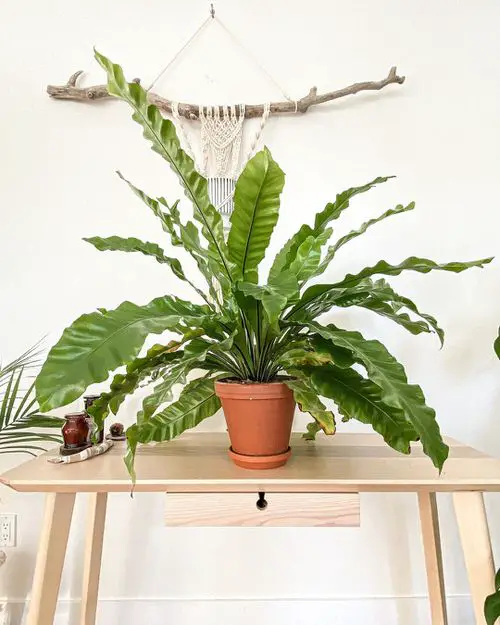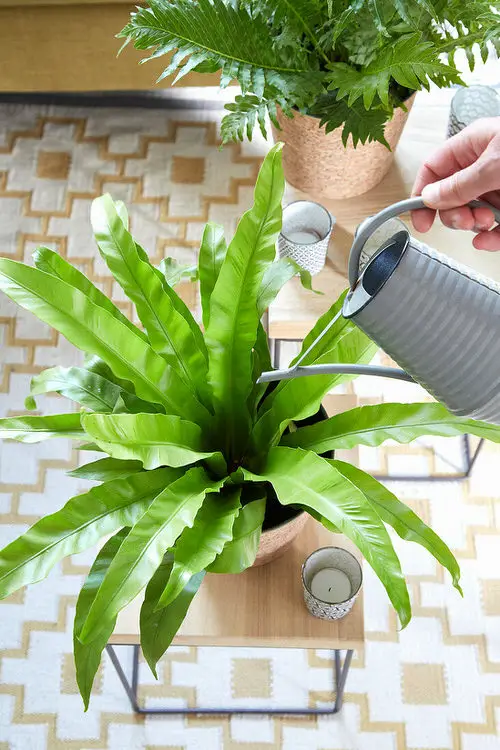Bird’s Nest Fern Care is not so difficult if you know what it needs to grow well! Read on to learn everything about this tropical fern in the post.

If you want an indoor plant that is known for its tropical looks, then what else then Bird’s Nest Fern Care. While it’s not super easy to grow it, you can still keep healthy and happy if you know these care instructions below.
Check out the best indoor ferns here
Bird’s Nest Fern Information
Bird’s nest fern belongs to the Aspleniaceae family and is native to the tropical forests of Southeastern Asia, Eastern Australia, and Hawaii. This fern got its name from stiffly curled new leaves coming out from a brown rosette in the center.
This is popularly grown as a houseplant, the mature size can be up to 3-5 feet tall and 2-3 feet wide. It has a slow growth rate and requires a moderately warm and stable indoor environment to thrive.
Learn everything about growing ferns from division here
Best Pot Size for Bird’s Nest Fern

You can start the plant in a 6-10 inches pot, the actual pot size depends on your specimen. Always select one size bigger pot than the rootball and make sure it has sufficient drainage holes in the bottom. As it is a slow grower, don’t worry much about repotting anytime soon. For the best display, showcase the plant in a pot on a plant stand or get a hanging basket. Apart from that, they also become great kokedama plants!
Best Types of Bird’s Nest Ferns You Can Grow
- ‘Osaka’: Has strap-like narrow leaves with rippled margins.
- ‘Crispy Wave’: It offers sword-shaped ruffled leaves.
- ‘Victoria’: This variety has wavy, long, tongue-shaped fronds.
- ‘Antiquum’: It looks beautiful with the wavy leaf edges.
Here’s everything you need to discover to grow ferns in water!
Requirements for Growing Bird’s Nest Fern
Light
This fern prefers filtered sunlight. Being an epiphyte, it loves moderate shade. This is why never expose the plant to direct sunlight. While growing indoors, make sure it gets plenty of indirect light all day.
Soil
Use a well-draining and loose growing medium that is rich in organic matter and doesn’t dry out quickly. For best growth, add peat moss or coco peat to increase the moisture retention ability of the soil.
You could also add sand or gravel for good drainage, along with regular potting soil. One more option is to grow them in the orchid mix as orchids and bird’s nest ferns have somewhat similar growing requirements.
Water
Bird’s nest fern loves constant moisture in the growing medium as it is not drought tolerant. However, when growing indoors, make sure you avoid waterlogging and very frequent watering as these plants don’t appreciate soggy soil either. It’s best to water when the top one-inch soil appears dry.
Also, avoid spilling water on its center and fronds to keep most of the potential diseases at bay. Otherwise, the nest-like center would hold water, which will lead to infection, mold growth, and rot.
Temperature and Humidity
This fern flourishes in a warm frost-free climate. The ideal temperature range is between 60-85 F (15-30 C), but it can be happy in temperature down to 50 F (10 C) and up to 95 F (35 C). While growing indoors, protect the plant from cold drafts and avoid keeping it near an air-conditioning vent.
The bird’s nest fern is native to rainforests, so naturally, it likes high humidity and moist surroundings. This is why you can also try to grow in your kitchen or bathroom. And if you have a greenhouse, that would be the best place for it to grow.
For improving humidity, use a humidifier or set the pot in a tray filled with water and pebbles. Do not allow the bottom end of the pot to touch the water in that tray, as it can cause root rot.
Check out the best ferns for hanging baskets here!
Bird’s Nest Fern Care

Fertilizer
When the plant is actively growing, usually from spring to mid-fall, feed it with any of your regular balanced liquid fertilizer diluted to one-quarter of its recommended strength, once in 4 weeks. Do not fertilize the plant in winters.
Alternatively, you can also side-dress the pot with compost or well-rotted manure, the plant will love it. You can also occasionally apply used tea leaves or coffee grounds to enrich the soil.
Re-potting
Re-pot the plant every two to three years or when you see it outgrows the current container; in spring. Use a planter that’s one size bigger than the old one. Also, it’d be a good idea to use a fresh potting mix.
Pests and Diseases
Bird’s nest ferns can be affected by aphids, fungus gnat, mealybug, and other common houseplant insects. You can repel them by using natural insecticidal soaps.
To keep most diseases at bay, avoid wetting the foliage and its center and overwatering the plant.
Check out some of the best epiphytic ferns here
Propagating Bird’s Nest Fern
It’s a bit tricky to propagate bird’s nest ferns. You cannot plant them by leaf or stem cuttings, and they also can’t be divided or grown in the form of offsets. Either buy plants from a plant center or propagate some from the spores that are hazy brown spots on the undersides of fronds.
- Gently cut off the fronds when spores become wide and fuzzy. Sperate them from the fronds using a knife and keep them in a paper bag.
- Take a pot with sphagnum moss, put it on a dish of water, and spread the spores on the top of it.
- Keep the container in a shady, warm area.
- The spores will germinate in 4-6 weeks.



I live in south east asia. Birds nest ferns in my area are outdoor plants.i have several and I have one in my backyard that is 5 ft tall and it takes 3 people with arms spread to encircle it. Its huge so no hate here but you might want to check out the outdoor growing birds nest ferns